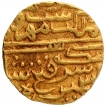This Lot is closed.
- P-Auction # 30
- Bids: 1
- Views:498
| Start Price 400000 | Estimated Price 400000-600000 |
| login, to view Hammer value | |
| Quick Description | ||||
|---|---|---|---|---|
| Denomination | Dinar 01 | Mint | Kashmir | |
| Metal | Gold | Year (AH/VS/SE/AM) | AH 876 | |
| Full Description: Kashmir Sultanate, Hasan Shah & Fath Shah, Dar-ul-Sultana Kashmir Mint, Gold Dinar (Mule?), AH 876, Obv: The Kalima Shahada within a circle, epithet Dar-ul-sultana & Hijri year 876, Rev: kibr-i-mamlakat kih muhr (mihr)-i-daulat ast, sikkah-i-fath shah sultan ain Kashmir ast (the glory of the kingdom, which is the mohur (sun) of the state, is the coin of Fath Shah of Kashmir), 11.28g, 20.00mm, (G&G # mule wtih K30 & K55), one test mark, choice very fine, Exceedingly Rare. Note: This specimen, which is possibly a mule, is struck using the dies of two different rulers of Kashmir Sultanate, Hasan Shah and Fath Shah. The obverse clearly contains the Kalima Shahada within a circle and the date AH 876 in the margin. This date lies within the reign of Hasan Shah, who ruled between AH 876-889, and an identical die is listed by Goron & Goenka vide reference no. K30 that illustrates this fact. The legend in the reverse reads 'Kibr-i-Mamlakat Kih Muhr-i-Daulat Ast, Sikkah-i-Fath Shah Sultan ain Kashmir Ast', and it clearly identifies the ruler's name as Fath Shah whose reign was from AH 892-904, and an identical die is listed by Goron & Goenka vide reference no K55 to establish this. It is also possible that Fath Shah reused the dies of Hasan Shah. Considering the equal quality of the two sides in this specimen, if this is the case it indicates that the older die had been used in a limited number of strikes during the reign of the Hasan Shah and/or that a strict control over the mints had been maintained by the administration which allowed older dies to be preserved and reused in such manner. Such occurences as strange nevertheless. Despite, and maybe because of, this anomaly, this is an important con from the Kashmiri Shah Miri Sultanate.
| ||||


